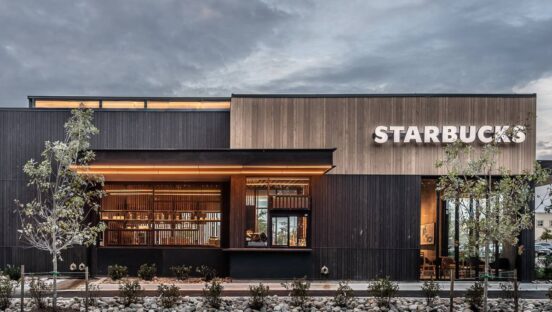Starbucks welcomes competition, CFO Rachel Ruggeri says.
It keeps the brand sharp and shines light on what the coffee giant does best—providing experiences in whichever way customers want to use its services. Out of the chain’s roughly 9,300-store U.S. corporate footprint, 70 percent are drive-thru, 29 percent are cafes, and 1 percent are pickup only. Ruggeri noted drive-thru stores produce the best unit economics, but the brand understands the importance of having locations that fulfill different uses.
“It’s important to be able to have stores that meet customers for different occasions and different reasons. And so pickup is a perfect example of that. It doesn’t have the unit economics that are quite that of the drive-thru, but it meets a customer need, and it helps with overall demand,” Ruggeri said at TD Cowen’s Seventh Annual Future of the Consumer Conference. “When we think about our opportunity in the future, it’s how do we leverage our portfolio to unlock capacity but also in a way that best meets the customer needs and demands?”
The latest evolution is delivery-only stores, which focus on a sales channel that is a “more and more meaningful part of our business,” Ruggeri said. Last year, Starbucks revealed it would form a national partnership with DoorDash to go alongside Uber Eats. It began by launching services in Northern California, Texas, Georgia, Florida, and other markets in January. A nationwide rollout was expected to happen by March.
Starbucks’ delivery channel grew 21 percent year-over-year during the chain’s fiscal second quarter, which equated to a 23 percent sales mix. CEO Laxman Narasimhan told investors in May delivery demand has remained strong even with consumers getting out more, meaning the channel is “highly incremental and interwoven into our customers’ lifestyles.” Additionally, Starbucks views the prototype as a way to remove complexity for customers and employees, as opposed to filling a location with drive-thru, mobile order pickup, and in-store dining.
The company is reportedly working with CloudKitchens, a ghost kitchen company run by Uber co-founder and former CEO Travis Kalanick, according to Business Insider. The media publication found local permits showing Starbucks was building a ghost kitchen in at least one San Francisco location. It’s scheduled to open in August.
The brand is also exploring drive-thru-only models where there is one traditional lane and another that services digital orders, which has become a crucial part of business. In the second quarter, mobile ordering mixed 47 percent, a 4 percent increase year-over-year. There are close to 31 million rewards members that have been active within the past 90 days; Ruggeri said about one out of every U.S. adult is part of the loyalty program.
“The fact that we have a leading digital program is really an advantage for us,” Ruggeri said. “And we have the opportunity to continue to evolve that, as I shared earlier around creating new and relevant experiences for customers. And when we think about the very best marketing vehicle we have today, it’s the digital program, and it’s our connection with our rewards members. So if we were to see the business soften in some way or the pressures that come with some of the headwinds in the current environment right now, one lever that we can always pull is continuing to be able to speak directly to those customers.”
Innovative store designs are part of an overall Reinvention Plan that Starbucks revealed in September. Other major components of the strategy include an incremental $450 million investment in new equipment and enhancement to the employee experience (digital tipping, career mobility, well-being benefits, etc.).
As part of the announcement, the brand also projected same-store sales growth between 7-9 percent globally and in the U.S. from 2023 to 2025. Ruggeri said Starbucks is becoming more confident in this expectation with every month and quarter that goes by, thanks to growth in customization and cold beverages, expansion of the digital program, and rewards members who pay higher and visit more often.
Ruggeri said the biggest difference between September and now is that Narasimhan transformed the Reinvention Plan into a more global ideology—especially counting markets outside of China. For example, Japan and the U.K. are benefiting from new customer behaviors. The two markets experienced double-digit same-store sales for the eighth straight quarter because of more drive-thru shops and locations in the suburbs.
The executive said Starbucks has “gotten it right for a very long time,” but that doesn’t mean there isn’t room to change and improve. All the opportunities uncovered by the Reinvention Plan during the past few months confirm as much.
“Whether it be through the drive-thru, whether it be through digital, whether it’s through an import experience, delivery, it’s creating the very best experience,” Ruggeri said. “And whether it be through product, whether that be through convenience, all of those different opportunities are the way that we set ourselves apart. … We have great opportunity in the future. So I’m actually encouraged, Laxman uses a phrase that says, we have limitless opportunity, and I truly believe that even after all these years.”








